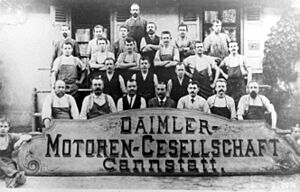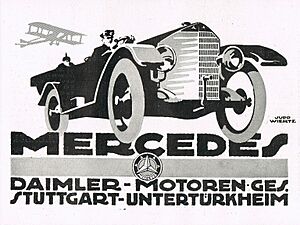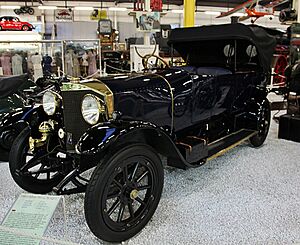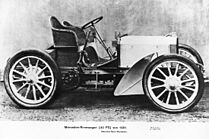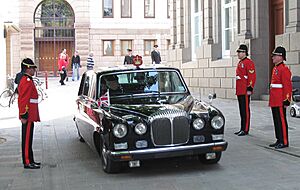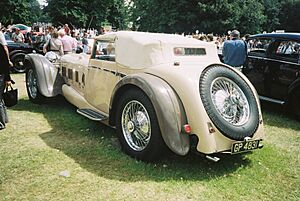Daimler Motoren Gesellschaft facts for kids
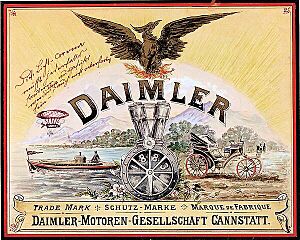 |
|
| Industry | Automotive |
|---|---|
| Fate | Merged with Benz & Cie |
| Successor | Daimler-Benz (1926) |
| Founded | 1890 |
| Founder | Gottlieb Daimler Wilhelm Maybach |
| Defunct | 1926 |
| Headquarters | Cannstatt, Stuttgart, Germany |
| Products | Automobiles |
| Brands | Mercedes |
Daimler-Motoren-Gesellschaft (often called DMG) was a German company that made engines and later cars. It operated from 1890 until 1926. Gottlieb Daimler (1834–1900) and Wilhelm Maybach (1846–1929) started the company.
DMG first made petrol engines. After some successful race cars were built for Emil Jellinek, the company started making the Mercedes car model in 1902. Car production quickly became DMG's main focus.
After World War One, Germany faced a tough economic time. Because of this, DMG joined with another car company called Benz & Cie. in 1926. They became Daimler-Benz and started using Mercedes-Benz as their car brand. Later, in 1998, the company merged with Chrysler Corporation to form DaimlerChrysler. In 2007, it changed to Daimler AG, and in 2022, it became the Mercedes-Benz Group.
Contents
How Daimler-Motoren-Gesellschaft Started
In 1882, Gottlieb Daimler and Wilhelm Maybach left their old jobs at a company called Deutz AG Gasmotorenfabrik. In 1890, they started their own engine business, Daimler Motoren Gesellschaft (DMG). Their goal was to build small, fast engines based on new technology they had created.
Daimler and Maybach made amazing inventions for cars. These included the four-stroke petrol engine and the carburetor. They wanted to make small engines that could be used on land, in the sea, and in the air. This idea later inspired the famous three-pointed star logo, with each point showing a different way their engines could be used.
In 1887, Daimler bought a property in Cannstatt, Germany. Here, they built engines for their successful Neckar motorboat. This place quickly became important for the growing car industry.
DMG faced money problems because they weren't selling enough engines. So, in 1890, they teamed up with some wealthy investors to turn their private business into a public company. The investors were more interested in making stationary engines (engines that stay in one place) because they sold well.
Daimler and Maybach really believed in making cars. They even left DMG for a short time because of disagreements with the investors. But in 1896, Daimler's friend, Frederick Simms, convinced the investors to bring Daimler and Maybach back. Their original business joined with DMG again. Daimler became the General Inspector, Maybach became the chief Technical Director, and Simms became a director.
In 1892, Maybach designed the Phönix engine, which had two cylinders and a new carburetor. DMG started selling engines all over the world, from New York City to Moscow.
The first Daimler car came out in 1892. In 1895, they made a two-cylinder car, and in 1897, DMG's first car with an engine at the front, a four-seat open car, was released.
Gottlieb Daimler passed away in 1900. Later, DMG's successful Mercedes cars changed the company's focus. These cars were based on race cars designed by Wilhelm Maybach for Emil Jellinek. Jellinek wanted a safer and more modern car. Maybach continued as a designer for a while, but he left in 1907. Gottlieb's son, Paul, took his place.
Growing the Car Business (1902-1920)
DMG's car sales really took off, especially with the first Daimler-Mercedes engine. This engine was designed by Maybach and used in race cars built for Emil Jellinek in 1900. This race car was later known as the Mercedes 35 hp. The company needed more space, so they expanded to a new factory in Untertürkheim.
In 1902, DMG made the first Mercedes models, including the famous 60. This car could go up to 120 km/h (75 mph) and was a top car for both touring and racing. Many other car makers copied it. Because of the Model 60's success, DMG's number of employees grew from 821 in 1903 to 2,200 in 1904.
From 1906 to 1913, DMG continued to grow. They built new facilities and relied less on outside suppliers. More machines were used, making production much faster. In 1911, DMG's shares were listed on the Stuttgart stock exchange.
Berlin-Marienfelde Factory
On October 2, 1902, DMG opened a new factory south of Berlin. At first, it only made engines for motorboats and ships. Later, it started making trucks (in 1905) and fire trucks (in 1907). This area became a hub for the car industry.
Untertürkheim Factory
Untertürkheim was a great place for a large factory. It was near the Neckar river and a railway line. The local mayor sold the land at a low price and helped arrange for a railway extension and power from a nearby hydro-electric plant.
DMG planned to open the factory in 1905. However, a fire destroyed the original Cannstatt factory in 1903. This made them speed up work on the new factory. The new building, with its unique roof, started production in December 1903. More and more people came to work there.
On May 17, 1904, Untertürkheim became DMG's main office. By the 1920s, almost all car production, from making metal parts to putting cars together, happened at this one site. In 1925, DMG's design team also moved there.
The Great Cannstatt Fire (1903)
On the night of June 10, 1903, a big fire destroyed the original factory in Cannstatt. All the machines and 93 finished Mercedes cars were lost. This was a quarter of their yearly production. A small museum with historical items, like Daimler-Maybach's first motorcycle, the Reitwagen, was also destroyed.
The workers who lost their jobs still received some pay and extra food. Other nearby businesses lent workshops so DMG could keep producing. DMG also started a Relief Fund, which was one of the first worker insurance plans. They also began building firewalls in all their factories to prevent future disasters.
The next year, 1904, the entire operation moved to Untertürkheim. The last car made in the old Cannstatt factory rolled out in early 1905.
Sindelfingen Factory
When World War One started in 1914, there was a rush to make war supplies. In late 1915, DMG opened the Sindelfingen factory. This factory made military vehicles, aircraft engines, and even whole airplanes. After the war, due to rules from the Versailles Treaty, this factory only made car bodies.
Motorboats and Cars
Daimler and Maybach started making motorboats early on, in 1886. Their first boat, the Neckar, was 4.5 meters long and could go 11 km/h (6 knots). It was the first motorboat in the world and was tested on the local Neckar river. This boat became DMG's first big success, partly because Germany's roads were in poor condition.
Daimler sold licenses for his car engines all over the world. This included France, Austria, the UK, and the United States.
The first DMG car was sold in August 1892 to the Sultan of Morocco.
Commercial vehicles, like trucks, were also made using the Phoenix engine. But until Daimler died in 1900, the designs for these vehicles were not standardized.
In 1902, the Mercedes car was built. It was compact and modern, with many new features. This car made the company's leaders much more interested in making cars. Mercedes then became DMG's main car brand name. Some other models included the Mercedes Simplex (1902–1909), which was "easy to drive," and the Mercedes Knight (1910–1924). All models were named based on their horsepower.
The first truck, which could carry 1.5 tons, was sold in London in 1896. It had a Phoenix engine at the back that made 4 horsepower.
In 1897, DMG began making light commercial vehicles. These were popular in the United Kingdom.
At the first Paris Motor Show in 1898, DMG showed a 5-ton truck with an engine at the front.
The Phoenix Engine (1894)
In 1894, Gottlieb Daimler, his son Paul, and Wilhelm Maybach designed the Phoenix engine. This engine impressed the car world because it had:
- four cylinders placed upright and side-by-side (a first for a car engine)
- exhaust valves operated by a camshaft
- a special spray-nozzle carburetor (patented by Maybach in 1893)
- better belt-drive system.
This engine was used in cars, trucks, and boats. It became DMG's main product until the Mercedes car came out in 1902.
The Mercedes Car (1900)
In 1902, a car that would later be called the Mercedes 35 hp was created by Maybach. It was made for a successful Austrian businessman named Emil Jellinek. He loved the Phoenix engine and race cars. The name Mercedes came from an engine Maybach built for Jellinek in 1900, which could make 35 horsepower. Jellinek wanted this engine to be called Daimler-Mercedes. When it was successful, he asked for a new car model that he would sell and use himself. This car was later known as the Mercedes 35 hp.
Jellinek was also a race car driver. He painted "Mercedes" (which means godsend in Spanish) on the cars he raced. This was the name of his 10-year-old daughter. Jellinek wanted faster cars, so he went to Stuttgart to meet Wilhelm Maybach and Gottlieb's son, Paul Daimler. Together, they designed a new type of car that would be "larger, wider, and with a lower center of gravity." A small number of these race cars were made for Jellinek. This was the first real car designed by DMG, not just a carriage with an engine added to it.
This new car combined Maybach's advanced 4-cylinder engine with a new frame. It amazed the motorsport world in 1901. Jellinek promised to buy many of these race cars (36 cars for a lot of money) if he could also be the only seller in Austria-Hungary, France, Belgium, and the US. He also wanted the engine to be called Daimler-Mercedes and to join the company's board.
In June 1902, DMG realized they had already given their Daimler trademark rights to another company in France. So, they decided to name all their cars Mercedes after the engine. They started producing the Mercedes series. The high demand for the car soon made DMG work at full capacity.
Car Racing
In the early days, car races were a great way for car makers to advertise their products. So, both DMG and its big rival, Benz & Cie., put their best cars on the track. Daimler cars usually beat Benz cars until 1908, when a Benz car set a land speed record. But in the years after that, both brands were equally good.
International Business
DMG grew by having a branch company in Austria called Austro-Daimler.
French Licenses
A man named Edouard Sarazin started talks to get permission to build Gottlieb Daimler's engines in France. After he died, his wife, with help from Émile Levassor and René Panhard, succeeded. They sold their first engine in 1887.
Armand Peugeot, one of their customers, started putting Panhard & Levassor engines in his vehicles. He got the Daimler license from them. Peugeot did very well selling cars in the German market.
Panhard & Levassor designed a complete car. Levassor put the engine (Daimler's) over the front wheels. This made the car more balanced and easier to turn. This car, sold in October 1891, had rear-wheel drive, a pedal clutch, a front radiator, and steering by a lever.
Historians often say that the car was "a German invention, while France helped it become popular." This is because Karl Benz received the first patent for a car he designed in 1885.
American Licenses
In 1888, Gottlieb Daimler worked with a German-born piano maker named William Steinway in New York. They built stationary and marine engines. Later, in 1892, they also built cars that were exact copies of the German designs. This business was sold after William Steinway died in 1896.
British Licenses: The Daimler Motor Company Limited
In 1890, Frederick Richard Simms, a friend of Gottlieb Daimler, returned to the United Kingdom. He brought the Phoenix engine for boats and also thought about using it for cars. He got the rights to Daimler's patents for Britain and its empire. In 1893, Simms formed The Daimler Motor Syndicate Limited (DMS).
In 1895, Simms received an offer from a London businessman named Harry J. Lawson. Lawson wanted to buy all the Daimler rights. As part of the deal, Simms arranged for DMG to take Gottlieb Daimler back, since Daimler and Maybach had left DMG. A new agreement was signed on November 1, 1895. This brought the divided Daimler-Maybach and DMG businesses back together and made them stronger. In early 1896, Lawson started The Daimler Motor Company Limited (DMC) in London. Gottlieb Daimler was a director of this new company, which had its factory in an old cotton mill in Coventry.
In 1910, the Daimler Motor Company joined with BSA (which made weapons). It started making military vehicles and dropped the word "motor" from its name.
For over 65 years, The Daimler Company Limited made many high-quality vehicles. These included buses, ambulances, fire engines, some trucks, and especially expensive medium and large cars. Their cars were known for their unique radiators. Until the early 1950s, people often said, "the rich buy Daimlers, the newly rich buy Rolls-Royce."
In 1960, the business was sold to Jaguar. Jaguar soon started making cars that looked very similar to Daimlers, often only different by the grille and name badge. In 2005, the only Daimler models being made were luxury cars, like the Daimler Super Eight.
The Daimler name moved with Jaguar through different company changes, eventually ending up with Ford. In 2008, the current owners of Jaguar and Daimler, Tata Group, said they might make Daimler a "super-luxury brand" to compete with Bentley and Rolls-Royce.
Airships and Airplanes
Daimler built the engine for the world's first airship powered by petrol in 1888. From 1899 to 1907, DMG provided engines designed by Maybach for Zeppelin airships. Wilhelm Maybach left DMG in 1909. After that, Maybach and his son Karl started their own company and continued to supply engines for airships.
During the First World War, starting in 1915, the Sindelfingen factory made many airplanes and aircraft engines. After the war, making aircraft was forbidden under the rules of the Treaty of Versailles.
Aircraft Models
- Daimler D.I
- Daimler G.I
- Daimler L11
- Daimler L14
The Three-Pointed Star: Land, Water, and Air
In the 1870s, while working for another company, Daimler sent his wife Emma Kunz a postcard. He drew a three-pointed star on it, marking his home. He wrote: "one day this star will shine over our triumphant factories." This idea later inspired Daimler and Maybach as they developed light and powerful engines for "land, water, and air."
In the 1900s, after the Mercedes cars became successful, DMG still needed a trademark. Paul and Adolf Daimler, Gottlieb's sons, suggested using the three-pointed star symbol. DMG's board agreed in June 1909. They also registered a four-pointed star. The four-pointed star later became the logo for other aerospace companies.
The three-pointed star first appeared on cars in 1910. In 1916, it was put inside a circle with four more stars. The name Mercedes or the factory name (like Untertürkheim) was also included. In 1937, the familiar three-dimensional three-pointed star inside a circle was officially registered by Daimler-Benz.
German Economic Crisis (1920s)
DMG was one of Germany's most important businesses during the German economic crisis after World War One. In 1920, its value tripled, and in 1922, its main office moved to Berlin.
After the war, the German car industry struggled. People weren't buying many cars, and the government taxed cars as luxury items. There was also a shortage of petrol.
In 1923, DMG's production dropped to 1,020 cars. The average cost of a car was 25 million German marks. Strikes and high inflation pushed DMG to its limits. To survive, DMG even made Mercedes bicycles and typewriters. They even printed their own emergency money!
Daimler-Benz and Mercedes-Benz (1926)
To survive the financial problems, Benz & Cie. suggested merging in 1919, but DMG said no. As the German crisis got worse, the companies met again in 1924. They signed an "Agreement of Mutual Interest" that would last until the year 2000. They agreed to work together on design, production, buying, selling, and advertising. They marketed their cars together but kept their separate brands.
On June 28, 1926, DMG and Benz & Cie. officially merged to form Daimler-Benz AG. Their main office was at the Untertürkheim factory.
Since they couldn't use "Daimler" on all their products, their cars were named Mercedes Benz. This honored DMG's most successful car model and the last name of Karl Benz. The new logo was the three-pointed star surrounded by the traditional laurels from Karl Benz's logo, with "Mercedes Benz" written on it. The next year, 1927, car sales tripled to 7,918, and they started making diesel trucks.
Fun Facts
- In 1890, DMG was selling engines to Russia. In 1910, it opened its first dealership in Moscow. From 1912, it supplied vehicles to the Russian Royal Court. Even after the war, Mercedes cars won many competitions in Russia.
- In 1892, DMG chose Otto Speidel to represent them in Munich.
- In 1896, Bavarian Engine & Automobile also started selling DMG products.
- In 1910, DMG opened a shop in Munich for trucks, buses, and motorboats.
- In 1914, one of the biggest races in history happened in Paris. To beat the favorite Peugeot team, DMG used an aircraft engine designed by Paul Daimler and Fritz Nallinger. This engine made 105 horsepower at 3100 rpm, much more than previous Mercedes engines.
- In 1921, DMG introduced the supercharged Mercedes Kompressormotor. This engine was very successful for both private buyers and on the race track.
|
See also
Sources
- Wise, David Burgess. "Daimler: Founder of the Four-Wheeler", in Northey, Tom, ed. World of Automobiles, Volume 5, pp. 481–483. London: Orbis, 1974.




